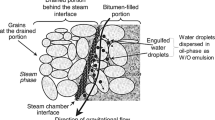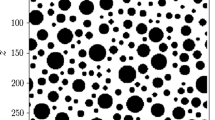Abstract
A one-dimensional ternary two-phase simulator has been extended to include improved physical properties. These physical properties - such as phase behavior, interfacial tension, residual saturations, relative permeabilities, phase viscosities, wettability, capillary pressure, adsorption and dispersion - are modeled as concentration dependent functions. Their functionality completely controls the chemical flood transport phenomena.
In this paper, the influence of phase behavior, interfacial tension reduction, mobility control and wettability alteration on chemical flooding are analyzed. In a subsequent paper the influence of capillary pressure, adsorption, and physical and numerical dispersion will be presented. The main application of the simulator here presented is to describe enhanced oil recovery processes. It may also be applied to describe oil spill cleaning and groundwater contamination.
Similar content being viewed by others
Abbreviations
- A :
-
cross-sectional area of reservoir (cm2)
- Ad:
-
adsorbed volume of component per unit volume of the porous medium
- D :
-
dispersion coefficient (cm2/s)
- e :
-
relative permeability exponent
- F :
-
interfacial tension factor defined in Equation (11)
- G 1, G 2 :
-
interfacial tension parameters, defined in Equations (10)
- K :
-
absolute permeability (Darcy)
- K c :
-
chemical partition coefficient, defined in Equation (3)
- k r :
-
relative permeability
- L :
-
length of system (cm)
- L supcinfa :
-
solubilization parameter, defined in Equation (1)
- L supwcinf0 :
-
swelling parameter, defined in Equation (2)
- N VC :
-
capillary number, defined in Equation (4)
- NX :
-
total number of grid blocks
- P :
-
pressure (atm)
- P c :
-
capillary pressure (atm)
- P e :
-
pressure at the outlet boundary (atm)
- S :
-
saturation
- S ar :
-
aqueous phase residual saturation
- S Or :
-
oleic phase residual saturation
- t :
-
time (s)
- T supjinf1 , T supjinf2 :
-
j-phase trapping parameters, defined in Equations (5), (6) and (7)
- u :
-
Darcy's velocity (cm/s)
- V :
-
volume fraction
- x :
-
distance along porous sample (cm)
- Z :
-
overall concentration
- α 1, α 2, α 3 :
-
phase viscosity parameters defined in Equation (14)
- λ :
-
A phase mobility, defined in Equations (A-4) and (A-5)
- σ :
-
interfacial tension (dyne/cm)
- σ supmininfj :
-
minimum interfacial tension value, below which the j-phase is thoroughly desaturated dyne/cm)
- φ :
-
porosity
- μ :
-
viscosity (cp)
- ε :
-
iteration error
- i :
-
component
- c :
-
chemical component
- D :
-
dimensionless
- m :
-
grid block number
- p :
-
petroleum component
- w :
-
water component
- s :
-
slug
- 0:
-
endpoint of function
- a :
-
aqueous phase
- H :
-
water-oil (no chemical) high interfacial tension system
- IN :
-
injection
- j :
-
phase
- k :
-
iteration level
- n :
-
time-step number
- o :
-
oleic phase
- r :
-
residual
References
Aziz, K. A. and Settari, A.: 1979, Petroleum Reservoir Simulation, Elsevier, New York.
Anderson, D. R., Bidner, M. S., Davis, H. T., Manning, C. D. and Scriven, L. E.: 1976, Interfacial tension and phase behavior in surfactant-brine-Oil Systems, SPE paper number 5811, presented at the Improved Oil Recovery Symposium, Tulsa, Oklahoma, March 22–24.
Bear, J.: 1972, Dynamics of Fluids in Porous Media, American Elsevier, New York.
Camilleri, D., Engelsen, S., Lake, L. W., Lin, E. C., Ohno, T., Pope, G. A. and Sephernoori, K.: 1987a, Description of an improved compositional micellar/polymer simulator, Soc. Pet. Eng. Res. Eng. 2(4), 427–432.
Camilleri, D., Fil, A., Pope, G. A., Rouse, B. A. and Sepehrnoori, K.: 1987b, Improvements in physical-property models used in micellar/polymer flooding, Soc. Pet. Eng. Res. Eng. 2(4), 433–440.
Camilleri, D., Fil, A., Pope, G. A., Rouse, G. A. and Sepehrnoori, K.: 1987c, Comparison of an improved compositional micellar/polymer simulator with laboratory corefloods, Soc. Pet. Eng. Res. Eng. 2(4), 441–451.
Douglas, J., Jr.: 1983, Finite difference methods for two-phase incompressible fluid flow in porous media, SIAM J. Numer. Anal. 2(4), 686–696.
Chaudhari, N. M.: 1971, An improved numerical technique for solving multidimensional miscible displacement equations, Soc. Pet. Eng. J. 11(4), 277–284.
Chaudhari, N. M.: 1973, Numerical simulation with second-order accuracy for multicomponent stable miscible flow, Soc. Pet. Eng. J. 13(2), 84–92.
Fanchi, J. R.: 1983, Multidimensional numerical dispersion, Soc. Pet. Eng. J. 23(1), 143–151.
Fleming, P. D., Thomas, C. P., Winter, W. K.: 1981, Formulation of a general multiphase multicomponent chemical flood model, Soc. Pet. Eng. J. 21(1), 63–76.
Helfferich, F. G.: 1981, Theory of multicomponent, multiphase displacement in porous media, Soc. Pet. Eng. J. 21(1), 51–62.
Hirasaki, G. J.: 1981, Application of the theory of multicomponent, multiphase displacement to three-component, two-phase surfactant flooding, Soc. Pet. Eng. J. 21(2), 191–204.
Lake, L. W., Pope, G. A., Carey, G. F. and Sepehrnoori, K.: 1984, Isothermal, multiphase, multicomponent fluid flow in permeable media - Part I: Description and mathematical formulation, In Situ 8(1), 1–40.
Larson, R. G. and Hirasaki, G. J.: 1978, Analysis of the physical mechanisms in surfactant flooding, Soc. Pet. Eng. J. 18(1), 42–58.
Larson, R. G.: 1979, The influence of phase behavior on surfactant flooding, Soc. Pet. Eng. J. 19(6), 411–422.
Larson, R. G., Davis, H. T. and Scriven, L. E.: 1982, Elementary mechanisms of oil recovery by chemical methods, J. of Pet. Tech. 34, 243–258.
Nelson, R. C. and Pope, G. A.: 1978, Phase relationships in chemical flooding, Soc. Pet. Eng. J. 18(5), 325–338.
Peaceman, D. W.: 1977, Fundamentals of Numerical Reservoir Simulation, Elsevier Amsterdam, pp. 65–81.
Pope, G. A. and Nelson, R. C.: 1978, A chemical flooding compositional simulator, Soc. Pet. Eng. J. 18(5), 339–354.
Pope, G. A., Wang, B. and Tsaur, K.: 1979, A sensitivity study of micellar/polymer flooding, Soc. Pet. Eng. J. 19(6), 357–368.
Pope, G, A., Carey, G. F. and Sepehrnoori, K.: 1984, Isothermal, multiphase, multicomponent fluid flow in permeable media, Part II: Numerical techniques and solutions, In Situ 8(1), 41–97.
Porcelli, P. C. and Bidner, M. S.: 1992, Modelización de la inundación, química de yacimientos petrolíferos, Revista Internacional de Métodos Numéricos para Cálculo y Diseño en Ingeniería 8(2), 157–175.
Porcelli, P. C. and Bidner, M. S.: 1994, Simulation and transport phenomena of a ternary two-phase flow, Transport in Porous Media 14(2), 1–20.
Saad, N., Pope, G. A. and Sepehrnoori, K.: 1989, Simulation of big muddy surfactant pilot, Soc. Pet. Eng. Res. Eng. 4(1), 24–34.
Saad, N., Pope, G. A. and Sepehrnoori, K.: 1990, Application of higher-order methods in compositional simulation, Soc. Pet. Eng. Res. Eng. 5(4), 623–630.
Thomas, C. P., Fleming, P. D. and Winter, W. K.: 1984, A ternary, two-phase, mathematical model of oil recovery with surfactant systems, Soc. Pet. Eng. J. 24(6), 606–616.
Van Quy, N. and Labrid, J.: 1983, A numerical study of chemical flooding-comparison with experiments, Soc. Pet. Eng. J. 23(3), 461–474.
Yortsos, Y. C. and Fokas, A. S.: 1983, An analytical solution for the linear waterflood including the effects of capillary pressure, Soc. Pet. Eng. J. 23(1), 115–124.
Author information
Authors and Affiliations
Rights and permissions
About this article
Cite this article
Bidner, M.S., Porcelli, P.C. Influence of phase behavior on chemical flood transport phenomena. Transp Porous Med 24, 247–273 (1996). https://doi.org/10.1007/BF00154093
Received:
Revised:
Issue Date:
DOI: https://doi.org/10.1007/BF00154093




